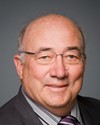Just a minute. I am the chair, sitting here, and I will take the responsibility.
We are interested in a new museum policy, a policy that works for all museums, big and small. I know I have gone over some of the MAP programs over the last while, and I see nothing small in those particular estimates.
I do have a rail museum in my riding. It's a very small museum and it has gotten no government funding over the years. It does have a caboose and it does have a station. They work very hard, as you do, and I give you those accolades.
I come from a little place called Sebringville, just outside of Stratford, Ontario, and one of our biggest nemeses is the old CN shops that are still there. They are in the downtown heart of the city and they've been just a pain in the rear for everybody. A person bought them and they're still there, half torn down and half not torn down. I think your rail museum is super. It's special, because these things do have to be preserved.
We are looking forward to a museum policy that will be good for all museums, big or small. But again, we have some questions, and some of those questions have been asked here today in regard to where the government should go. I must say that I have sat on this committee for the last two years, and I was one of the first people who brought up small museums three years ago. I was told by the president at that time when he was here that it was the first time he had heard small museums mentioned in a heritage committee meeting in the last ten years.
So yes, we as a government are very interested in small museums and in a small museum policy, but policy that is not only talking in dollars that can't be accessed. We want to have good policy that can be accessed somewhere down the road.
We're going to finish with someone over on this side, because we have to complete here quickly.
Mr. Angus has a point of order.





